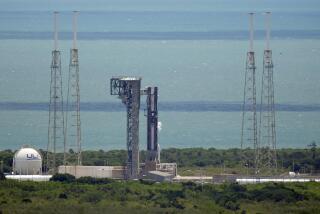Atlantis Lifts Off; Astronauts Deploy Satellite : Space: Launching had been delayed three times. The craft put into orbit will expand NASA’s communications system.
- Share via
KENNEDY SPACE CENTER, Fla. — After three launching delays, the shuttle Atlantis vaulted into orbit Friday with five astronauts who later released an immense communications satellite.
“Well done. Congratulations,” Mission Control told the crew after the satellite was spring-ejected from the cargo bay six hours into the flight.
A rocket on the satellite was fired an hour later, after the shuttle backed away to a safe distance, sending the craft spinning to a 22,300-mile-high orbit.
Atlantis rose from its seaside launching pad on time at 8:02 a.m. PDT. It was a welcome sight for space center workers who had struggled through three flight delays in the last two weeks, including one the day before.
Thursday’s launching attempt was canceled nine minutes before scheduled liftoff by bad weather. Two earlier delays were caused by failed parts.
“They all worked hard . . . “ launching director Bob Sieck said. “They got their reward . . . seeing Atlantis go into orbit with a 100% operating system that they made possible.”
Atlantis’ nine-day voyage is the 42nd shuttle mission. It is also the fifth time that astronauts have been sent to deploy a Tracking and Data Relay Satellite.
The newest $120-million satellite will expand NASA’s switchboard system in space, providing extra coverage between future space explorers and Mission Control. In addition, the system links ground controllers with about seven NASA satellites, including the Hubble Space Telescope, and an undisclosed number of military spy satellites.
Astronaut Shannon Lucid hit the switches to discharge the satellite from a raised tilt-table after successful system checks.
After about six hours, the rocket’s second stage was to be fired to put the satellite into a circular orbit. Ground controllers were to issue computer commands to extend the satellite’s twin solar panels and numerous antennas. Two of the antennas are plated with gold.
The 4,600-pound satellite will stretch 57 feet across once the solar panels are unfurled.
Once operational this fall, the satellite will replace the second-oldest TDRS craft, which will become a spare. The oldest satellite in the network already is a spare.
Spaceships previously needed to be in sight of a ground tracking station for the crew and Mission Control to communicate. Fifteen stations have been closed or transferred to other organizations since the first TDRS was launched in 1983. Four tracking stations remain in use, primarily for the critical first eight minutes of shuttle flight.
The National Aeronautics and Space Administration plans to send up two more TDRS craft by the mid-1990s. Managers estimate the program costs, including the next two satellites, at more than $3 billion.
Atlantis is scheduled to land Aug. 11 at the Kennedy Space Center.
Atlantis Mission Schedule
Liftoff: At 8:02 a.m. PDT. Orbital altitude will be 184 miles. In Orbit: Atlantis’ crew launched the TDRS satellite into a geosynchronous orbit 22,300 miles above the Earth. Landing: Mission duration is 8 days, 22 hours and 45 minutes. Primary landing site is the Kennedy Space Center in Florida. TDRS network: links shuttles and other low-orbit spacecraft with the ground.
Atlantis launched a Tracking and Data Relay Satellite (TDRS) shortly after liftoff.
More to Read
Sign up for Essential California
The most important California stories and recommendations in your inbox every morning.
You may occasionally receive promotional content from the Los Angeles Times.













